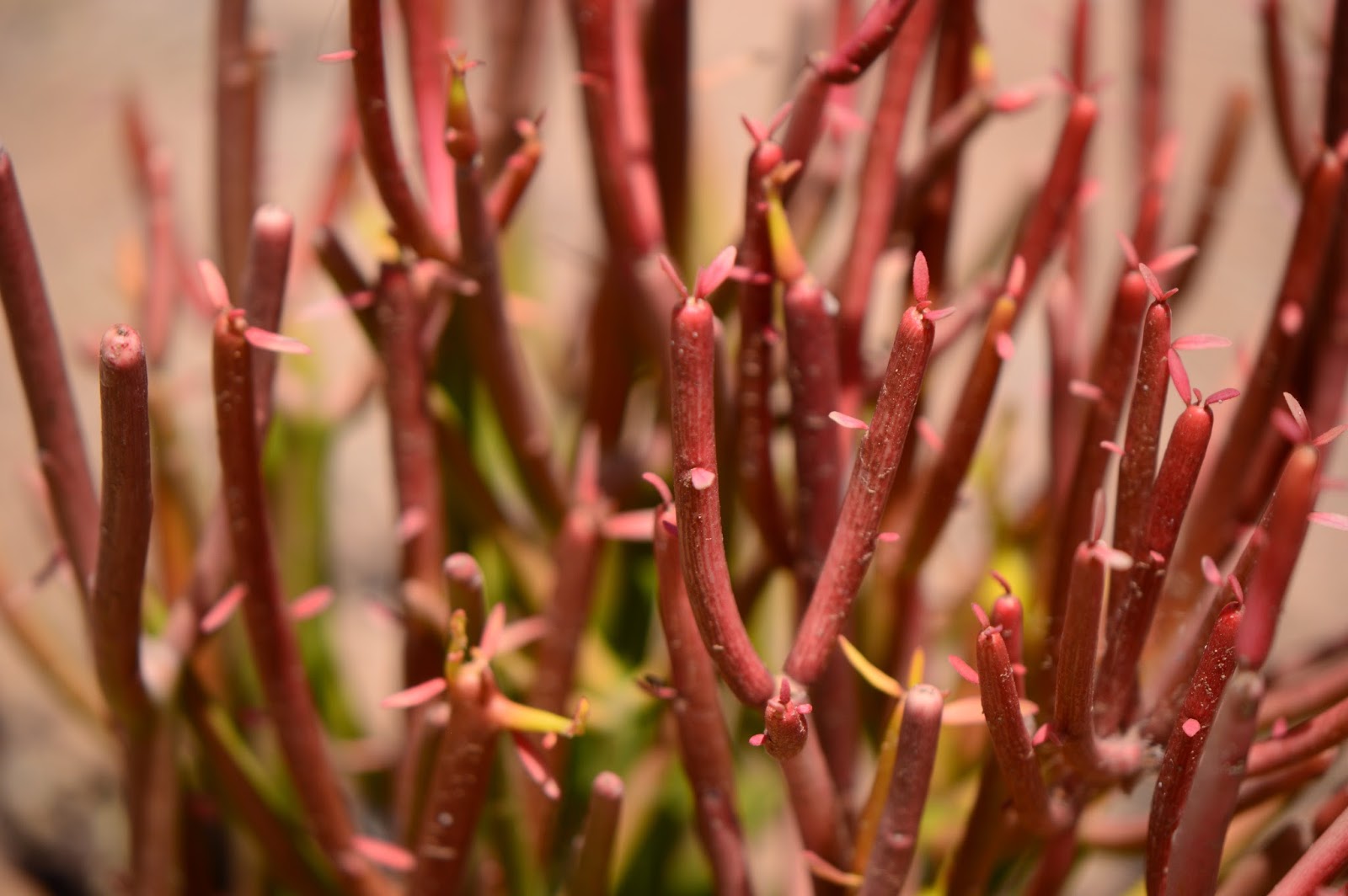The Dry Corner is a patch at the entrance/exit to the garden, the point at which one walks out into the big world (generally headed straight to the horse corrals). As it is furthest from the shade of the patio, I decided to make it the area where I used the most obviously xeric plants. This gives it a little different character than the rest of the garden, but also allows me to trial some wonderful species in an area reserved for their preferences.
I have developed the garden more or less from the edge of the patio downward (the west edge of the garden), though gaps exist throughout. So the east border, with the Dry Corner at one end, is one of the least fully planted areas. Featuring it for the end of the month view has changed that a little. I have gone ahead and added a few plants over the last couple of months. Here we are now...
It all looks very sparse still! But additions include Crassula "Campfire" in the foreground (foliage is colouring up nicely now it is in full sun)...
and a second Anigozanthos behind it - just a clump of rather dubious foliage at present; this was one of my recent purchases from the discount shelf so no picture available yet! To the far left is Senna nemophila. This young Australian shrub gave a few of its yellow blooms in early spring. The showing was rather brief, followed by one lone seedpod, since removed. It has not settled in as easily as I hoped. It is always a rather scantily clad bush, with its lovely narrow leaves forming a haze of pale green. However, there is quite a bit of yellowing of leaves, and some leaf drop. I don't know why at this point since this is said to be a well-adapted plant for the region. The second picture is from early March, when the few blooms appeared.
It grows just below the anchor of the Corner, which is the more or less weeping Acacia salicina. It has put out quite a bit of new growth this spring and is now officially taller than I am though its head droops such that the increase in height is not terribly obvious. But it is looking healthy and happy. It is hard to photograph as the stake bracing it is so much heftier than the tree itself. Here is a close-up of the leaves, at any rate!
Another new plant is Lampranthus vygie "Lilac Mist" (I think that is the name - it's too late at night to go check!) just on the edge of the panorama view above. It had plenty of flowers - hot pink rays and yellow centres - when I bought it, but they collapsed upon planting. Foliage is blue-green and rather attractive. I say this despite the fact that somehow I developed a rather negative attitude towards ice plant varieties generally - a silly attitude given their usefulness in extremely difficult garden situations! Perhaps growing this one will encourage a more positive view of them.
So much for the newbies! There are also the plants that have been in place for some months. The most noticeable are still the Berlandiera lyrata with its bright yellow daisies and Senecio "Blue Fingers", a handsome clump of the bluest foliage in the garden. Berlandiera has been blooming for months. I have found that it does need a fair amount of water to support this habit! For that reason I am debating relocating it, but perhaps not since it seems so well pleased with its current position. Besides, it's pleasant to be greeted by that chocolate scent on my way in and out of the garden.
Senecio keeps promising to bloom. It is biding its time. Although I am not growing it for the flowers, still the suspense does build up with a plant that sets buds and then holds them unopened for weeks.
A continual burst of bloom is coming from Tetraneuris acaulis, shown here with a friend. Unlike the Berlandiera, T. acaulis has put out a fine stand of little yellow daisies while demanding very little water. This is a wonderful dry-climate plant: vigourous, attractive, bright. The foliage is very low-growing, but the flowers stand well up on long stems, making the whole effect more visible.
Elsewhere in the garden, the transition to summer continues. Some plants have slowed or ceased blooming, among them the Lavender stoechas varieties, though L. s. "Blueberry Ruffles" seems to be in a state of actual collapse. L. s. "Madrid", on the other hand, appears to have paused in blooming merely to put on a burst of new foliage. Rather to my surprise, Eremophila "Outback Sunrise" is still throwing off the occasional bloom.
Perovskia atriplicifolia has finally begun blooming...
...and Cistanthe grandiflora continues to send up its exotic flower stalks loaded with buds, flowers, and spent blooms, all like so many baubles dancing in the breeze.
And, no pictures yet, but just today it appears that Salvia elegans will soon be in full bloom.
Well, that is all for this month's update. As always, I will link with the End of the Month View meme at The Patient Gardener, where many other updates can be followed as well.
One last picture of Anigozanthos "Bush Ranger", the wonderfully deep red flower in the Dry Corner.
Weather Diary: Sunny, High: 96 F (35.6 C)/Low: 62 F (16.7 C)
























































